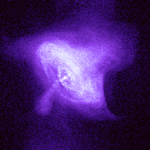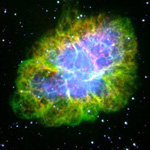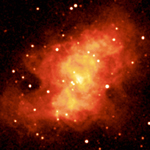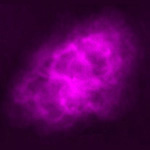What Do These Images Tell Us?
The Crab Nebula consists of a pulsar, a rapidly rotating neutron star at the center, surrounded by a bright diffuse nebula. The nebula, which is about six light years across, is expanding outward at 3 million miles per hour. The filamentary system visible in the optical images is near the outer boundary of this expansion. Both the nebula and the pulsar are bright sources of radiation in all wavelengths.
The radiation we observe from the Crab Nebula is produced mainly by high-energy particles accelerated by the neutron star. These energetic particles, which near the neutron star are thought to include anti-matter positrons as well as electrons, spiral around magnetic field lines in the nebula and give off radiation by the "synchrotron" process.
Comparing the X-ray, optical, infrared, and radio images of the Crab shows that the nebula appears most compact in X-rays and largest in the radio. The X-ray nebula shown in the Chandra image is about 40% as large as the optical nebula, which is in turn about 80% as large as the radio image. This can be understood by following the history of energetic electrons produced by the neutron star. Electrons with very high energies radiate mostly X-rays.




Return to Crab Nebula (28 Sep 99)


